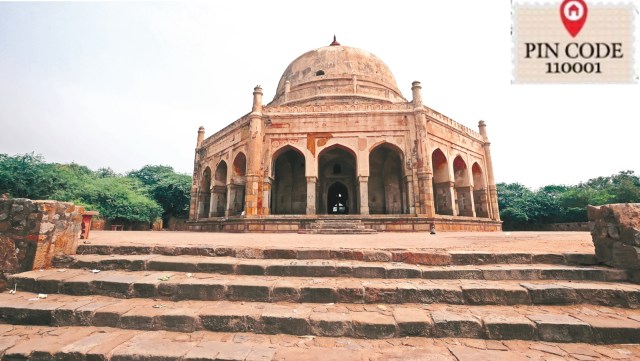In heart of Mehrauli, this Bhool Bhulaiyya is more than just a maze
Besides Adham Khan, his mother Maham Anga, Akbar’s wet nurse and foster mother, is also buried here. Although, only one gravestone is visible now.
 The tomb of Adham Khan in Mehrauli. (Express Photo by Gajendra Yadav)
The tomb of Adham Khan in Mehrauli. (Express Photo by Gajendra Yadav)Delhi’s historic Mehrauli area is home to several monuments — some renowned such as the Qutub Minar, others not as well known or completely unknown jutting out of various nooks and crevices. And then there is a third kind, which is familiar to local residents but for reasons that have nothing to do with the purpose the monument was originally built for.
One such structure is what is referred to as ‘Bhool Bhulaiyya (maze)’ by the residents. Situated opposite the Mehrauli bus terminal, with its walls serving as a stand for autorickshaws, this is the tomb of Adham Khan, a general and foster brother of Mughal Emperor Akbar.
For visitors, though, the name rings no bell. “Hum toh bhool bhulaiyya hi jaanein (we only know it as Bhool Bhulaiyya)”, says an elderly woman enjoying a somewhat pleasant evening after days of searing heat in Delhi.
On what gave the structure its moniker, author and filmmaker Sohail Hashmi tells The Indian Express: “The name comes from the stairs inside the walls. To ensure that the large dome does not fall off, buttresses were placed to lend some support. And to cover the buttresses, a circular outer wall was built. So, when you climb the stairs, entering the inner side of the dome, a gallery formed by the buttresses opens up. The outer opening comes after the inner opening, which is why it is difficult to trace the latter. Then you try to backtrack, and get lost in the process.”
Although the stairs have been closed off now, Hashmi remembers a time in his childhood, some 60-odd years ago, when he got lost inside.
A local legend in Mehrauli is that once a baaraat (wedding party) got lost inside the maze. Hashmi, though, dismisses the story. “There is not enough space inside for an entire baaraat to get lost!” he says.
Author and historian Swapna Liddle writes in her book, 14 Historic Walks of Delhi: “The eight-sided tomb is built mainly of grey quartzite, widely available in and around Delhi. The upper part of the building is covered with limestone plaster — sparsely decorated with carved or incised motifs…”
The tomb’s architecture is a confluence of the styles of different eras: While the shape is reminiscent of the Lodhi era and turrets reflect Tughlaq influence, the carvings are a marker of the Mughal period.
Says Hashmi, “In history, there are no such lines demarcating different eras. There are always periods of transition… The pillars have been built fitting large stones together. This was a technique in use in India before the 12th Century. The dome is built with rubble, a technology introduced in India in the 13th Century. While this monument was built in the 16th Century.”
Besides Adham Khan, his mother Maham Anga, Akbar’s wet nurse and foster mother, is also buried here. Although, only one gravestone is visible now.
Raza Rumi, in his book, Delhi by Heart, calls the tomb a “lonely structure” that “represents a twilight zone between the noisy outer market of Mehrauli and the ghostlike calm of the Delhi Ridge”.
For Asif Khan Dehlvi, a long-time Mehrauli resident and founder of Delhi Karavan, which conducts heritage walks in Delhi, the tomb forms a special part of his memories growing up.
“Around that time, I used to live in Chirag Dilli. Whenever I would go to Mehrauli to call on the dargah of Qutubuddin Bakhtiyar Kaki, I would often make a pitstop here and it never failed to mesmerise me. Curiously, despite its imposing façade, the structure is not visible from a distance. And then, it suddenly comes into view. Door se iski bulandi ka ehsaas hi nahi hota (You cannot make out its enormity from afar),” he tells The Indian Express.












